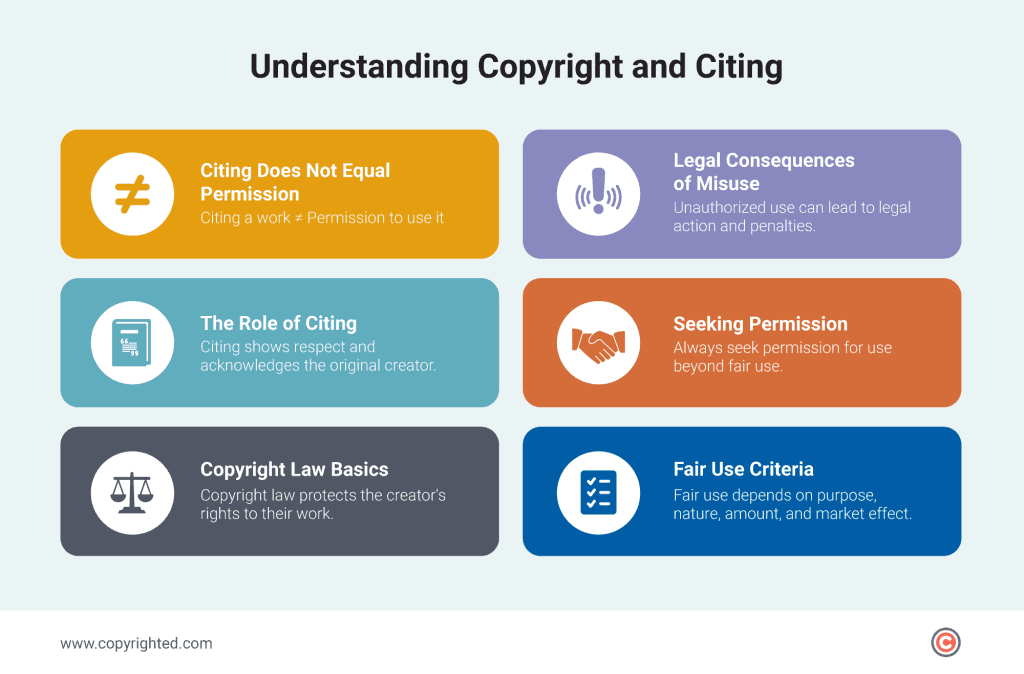A common misunderstanding in content creation is thinking that if you mention where you got something, or cite copyrighted work, you’re automatically allowed to use it without asking for permission from the owner.
Let me warn you now, this is not accurate.
This article aims to clarify this common misconception and shed light on the complex relationship between citing copyright, and fair use.
- Citing a work protected by copyright is not a free pass from infringement, permission to use is still required.
- Misconceptions about citing can lead to legal consequences like fines, content removal, and damaged credibility.
- Proper reference includes details like the author’s name, title, publication date, and source.
Table of Contents
Can You Use Copyrighted Material If You Cite It?
No, simply citing material does not grant you the right to use the work without asking permission from the owner.
While the act of citing demonstrates a commitment to transparency and an acknowledgment of the original creator’s work, it does not serve as a blanket authorization to use copyrighted content without asking for consent.
Another critical aspect to consider is whether you can use a copyrighted name. Mentioning or citing an author doesn’t grant automatic permission. Using such without proper authorization can lead to legal consequences, even if you provide an attribution.
Citing is a professional practice, but it doesn’t replace the requirement for authorization, especially when you use the material for monetary purposes.
Moreover, the misconception that citing alone grants the right to use copyrighted work without permission can lead to legal consequences. So, it’s important to be cautious.
Infringing on someone else’s protected work can result in legal action, potentially leading to severe consequences such as financial penalties, removal of the contested content, and damaged credibility for you and your content.
Laws are in place to safeguard creators’ rights, giving them exclusive control over their works. This control extends to reproduction, distribution, display, and the creation of derivative works.
As a content creator, you need to have a proactive approach to compliance. Recognize that every piece of creative work reflects someone’s intellectual effort.
The digital age offers a lot of opportunities for collaboration and sharing, but these endeavors must be rooted in respect for intellectual property rights.
To use copyright-protected material in your work, you must either obtain permission from the owner or establish a legal basis, typically through a licensing agreement outlining terms and conditions. It’s important to note that even if you cite the material and attribute it correctly, you must still seek permission or obtain a license if you plan to use it beyond what is permitted by fair use.
Fair use applies and is intended to allow certain limited uses of copyrighted content without authorization from the owner. However, this is a delicate concept and must be evaluated on a case-by-case basis.
Deciding whether a specific use is fair use relies on four key factors: the purpose and character of the use, the nature of the copyrighted work, the amount and significance of the portion used, and the impact of the use on the potential market for the original work.
While citing copyrighted pieces is an important practice for acknowledging the work of others, it should not be misinterpreted as a solution for using it freely without consequences.
To ensure compliance with copyright law, it’s important to obtain permission to use or establish a valid legal basis before incorporating and including any copyrighted pieces into your work.
Does Citing Prevent Copyright Infringement?
No, simply citing a source won’t prevent infringement of copyright.
Citing is a common and respectful practice in academic and professional settings, aiming to give credit to the original author and keep things transparent for your audience.
But here’s the catch: it doesn’t work like a shield that protects you from copyright breaches.
Despite its role in acknowledging the origin of information, citing without proper authorization will still be violating copyright laws.
The exclusive rights to creative works belong to the copyright holders, and using their work without permission goes against those rights.
By providing proper attribution to the material, you demonstrate that you have acknowledged the work’s origin and have taken measures to appropriately attribute it. This is especially important in fields like academia, journalism, and others that rely on accurate and trustworthy information.
Citing the copyright-protected work also allows your audience to access the original material, further supporting the intellectual discourse surrounding it.
While proper attribution reflects ethical conduct, it doesn’t provide legal immunity. Even if you do it right, you still need permission from the copyright owner, unless your use falls within the acceptable limits of fair use or other exceptions in copyright law.
According to Section 107 of the Copyright Act of 1976, fair use allows the use of copyrighted work for purposes like criticism, comment, news reporting, teaching, scholarship, or research without infringing on copyright.
In essence, while citing is a good practice in academic and ethical settings, it’s not enough on its own to protect you from potential copyright issues.

How Do You Cite Copyrighted Material Properly?
Now, let’s address proper citation and use of copyrighted material.
When you’re adding someone else’s work to your own, you need to construct a thorough citation. This should include key details such as the author’s name, the title of the work, the publication date, and the source from which it originated.
I suggest smoothly blending the cited material into your content. Make it clear which parts are your own ideas and which parts are from someone else’s work.
Also, be sure to follow the way your field suggests giving credit to the original creators, like using APA, MLA, Chicago, or another recognized style.
Not only does this practice show your dedication to transparency, but it also helps your audience to trace information back to its origin accurately.
Can You Use a Copyrighted Name?
No, generally you cannot use a copyrighted name without permission.
Using a copyrighted name without permission can lead to legal issues, including copyright infringement claims.
Copyright protects original works of authorship, including names in certain contexts, such as when they are part of a larger work (like a book, movie, or video game).
However, it’s important to note that trademarks, not copyrights, typically protect names, especially brand names or names of products and services.
Using a trademarked name without permission, especially in a way that could cause confusion or imply endorsement, is usually a violation of trademark law. Always seek legal advice or permission when considering the use of a copyrighted or trademarked name.
5 Quick Tips for Fair Use
While the doctrine of fair use is complicated, here are important tips for practicing it based on the four factors of fair use.
When working with copyrighted content, you need to consider:
- Purpose and Character: Consider the purpose of using the material. Transformative use by adding significant value, such as commentary, criticism, or parody, may lean towards fair use. But, mere reproduction without transformation is risky.
- Nature of the Work: Check whether the original work is factual or creative. Generally, using factual material in a transformative manner is more likely to be considered fair use.
- Amount and Substantiality: Be mindful of the portion of the work you’re using. Taking a small, reasonable excerpt may be more justifiable than reproducing a substantial part.
- Effect on Market Value: Assess the impact of your use on the market value of the original work. If your use potentially diminishes its value, it’s less likely to be considered fair use.
- Fair Use Checklist- This Fair Use Checklist is a user-friendly tool designed by Kenneth Crews and Dwayne Butler that can be used to help you make decisions regarding copyright and permissions.
When in doubt, you can always consult legal professionals familiar with copyright law. Their expertise can guide you through the concept of copyright and fair use and help you make informed decisions.
Final Word
Copyright protects the exclusive rights of creators, safeguarding their original works from unauthorized use or reproduction. While attribution is an essential practice that demonstrates respect and transparency, it does not grant usage rights on its own.
Compliance with copyright law requires obtaining proper authorization or establishing a valid legal basis, such as fair use. Remember to seek legal advice when needed and work towards fostering a culture that values intellectual property rights, promoting a fair and lawful approach to content creation and sharing.
Frequently Asked Questions
Can you use copyrighted material if you cite it?
No, citing does not grant permission; explicit permission is required.
Does citing prevent copyright infringement?
Citing shows respect but does not serve as a legal shield for copyright infringement, having permission from the owner is always necessary.
What details should be included in a proper citation?
The author’s designation, title, publication date, and source are essential for proper citation.
Is fair use a guaranteed exception for using copyrighted material?
No, fair use exceptions are subject to specific conditions; explicit permission is often safer.
Can you assume fair use if your use is non-commercial?
Non-commercial use does not automatically qualify as fair use; other factors must be considered.
What proactive steps should content creators take regarding copyright?
Content creators should seek explicit permissions and stay informed about copyright laws for responsible content creation.


